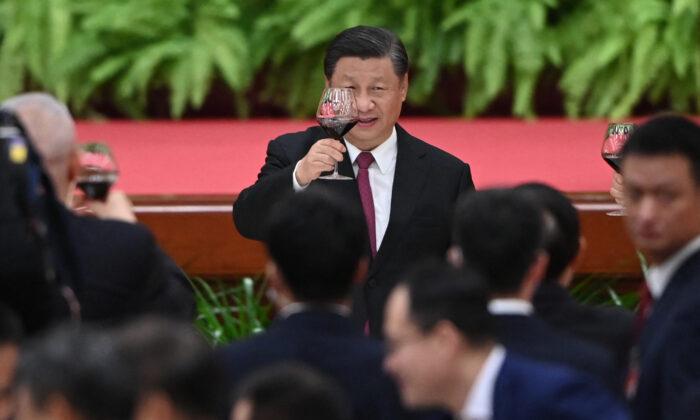A new cold war, initiated recently by the Chinese regime against the United States, has many similarities with the one launched by the former Soviet Union, but there is also a key difference.
The United States is presently involved in a second cold war. The first one was with the former Soviet Union; the one with the Chinese regime has only just begun. Both cold wars were launched by communist regimes opposed to democratic values and intended to replace the democratic values with their own “red” Marxist values through global conquest.
As the most powerful democracy, the United States has always been considered the enemy by both the Soviet Union and the Chinese Communist Party (CCP). The CCP’s political dependence on “red” ideology was exactly the same as that of the Soviet Communist Party, but its approach in the war against the United States is different from that of the Soviets.
The Soviets advocated the so-called peaceful race between East and West in order to avoid a nuclear war. The CCP, on the other hand, has been working to build up economic and military pressure so as to deter the United States, in the hope of laying a foundation for its eventual domination over parts of the world. This has always been its ultimate strategic goal.
The French newspaper Liberation published an article on May 26 quoting a commentator in Beijing as saying that “the possibility of a new Cold War between China and the United States is the concern of most observers.”
In an article published on June 12 by Chinese media GuanCha.cn, University of Chicago professor John Mearsheimer was quoted as saying: “Before the [coronavirus] outbreak controversy, people could argue whether China and the United States were really in a Cold War. But by now, I think it’s pretty clear that there is a Cold War.”
Duowei News ran another article on June 19 titled “If China’s Rise Leads to a World War, It Should Be With the U.S., Not India.“ The article stated: ”The road to the rise of great power is never a smooth one. ... If China needs war to establish its role and status in the global order, it should be a war between China and the United States.”
Is a Cold War Inevitable?
In the past, the experience of the Cold War was summed up mainly by Western experts on the Soviet Union. Beijing-leaning Western history scholars didn’t know anything about that Cold War and weren’t interested in it. Now that there’s a cold war happening between China and the United States, it poses a big problem for these historians. They know nothing about the U.S.–Soviet Cold War, the Soviet Union, or the Russian language. They are able to read Chinese, but they don’t know what to think of the U.S.–China cold war. Some of them hope there is actually no such cold war and that the whole problem will just go away.The Cold War between the United States and the Soviet Union provided merely an isolated example, and it was easy to attribute it to chance. But with the advent of this second cold war, the study of such conflicts will enter a new space, because we now are able to compare the two. And comparing the causes of the two cold wars, as well as their similarities and differences, is of great practical significance and reference value to judge the future direction of China and the United States.
- The biggest socialist country is pitted against the biggest capitalist country.
- The conflict was launched by the socialist country.
- The cause of the cold war in the socialist country was “democracy phobia” and a constant hostility toward the most powerful democracy, the United States, for fear that its citizens might find democracy more attractive.
- The red values of socialist countries have global conquest as their goal. Evidence for this can be seen in the post-World War II history of the Soviet Union and in the international relations strategy of the CCP under Mao Zedong.
- Before these two cold wars, there existed a honeymoon phase, with the United States maintaining the honeymoon with constant courtship and gifts. But in the end, the United States found it had only cultivated and strengthened its adversaries.
- Although the United States was often ill-prepared before the beginning of the cold war, once it entered into the cold war state, it would exert its institutional advantages and bring great pressure on its opponents.
- While the Soviet Union and China, the world’s two biggest communist countries, both initiated a cold war out of their fear of democracy, they each made different choices. The Soviet Union eventually chose to give up the Cold War, whereas the CCP chose to hide its strength and bide its time for 30 years. Having gained a little bit of a technical and economic foundation, it can’t help showing off.
The Cold War Initiators: ‘Red’ Regimes
The Cold War between the United States and the Soviet Union began after World War II when the Soviet Union installed communist regimes in the eastern European countries occupied by the Soviet’s Red Army.On March 5, 1946, Winston Churchill delivered a speech known as “The Sinews of Peace” (or the “Iron Curtain Speech”) at Westminster College in Fulton, Missouri. In it, he said, “From Stettin in the Baltic to Trieste in the Adriatic, an iron curtain has descended across the Continent.”
This prediction was soon confirmed by the Soviet plan for the conquest of Eastern Europe, and it culminated in the construction of the Berlin Wall in 1961. The war between the two sides started in earnest in 1962 with the crisis caused by the Soviet Union placing nuclear missiles in Cuba. After more than two decades of military expansion, the Cold War between the two sides finally ended during the Gorbachev era.
The cold war between the United States and China began with a series of “drawing sword” actions by the CCP this year.
First, China’s navy fleet and electronic spy ships went out to the waters off Midway Island, a U.S. military base on Sand Island, to conduct in-depth multi-service joint exercises and training with the CCP air force, rocket force, and strategic support forces, aiming at the U.S. forces on Midway Island and Pearl Harbor.
Secondly, after occupying the high seas in the South China Sea and building islands and military bases, China publicly declared that it had turned the high seas waters near Vietnam and the Philippines into a “fortress sea” for its strategic nuclear submarines to hit the United States with nuclear-armed intercontinental missiles.
Thirdly, the CCP announced its completion of space war deployment against the United States.
The first two provocations show that the CCP is able to aim and fire a nuclear missile at the United States at any time.
In regard to the third “drawing sword” action, I’ll cite the words of Duowei News in a June 26 article: ”On June 23, China successfully launched Big Dipper 3, the last global networking satellite, completing the deployment of its Global Navigation Satellite System constellation. ... The total completion of the Big Dipper system also means a significant increase in China’s military capabilities, with both ‘global’ and ‘precision’ capabilities, capable of more precise surgical strikes on global targets and detailed deployments on specific war sites.”
The Soviets Advocated So-called Peaceful Race Between East, West
Communist countries have global conquest as their goal.Like the Soviet communist regime, the CCP tightly adheres to Marxist ideology and the belief that the Communist Party will always be in power. This requires that the CCP always keeps up pressure on the United States. Its ideological rationale is that Marxism holds that capitalism would inevitably lose to socialism, and the Communist Party would represent the future of humanity. To succeed at it, communist regimes must keep preaching to their people about the achievements of socialism and the decline of capitalism, while demonstrating that their “red” regime is successfully overtaking the United States.
On Nov. 18, 1956, Nikita Khrushchev, the first secretary of the Communist Party of the Soviet Union, addressed Western diplomats at a reception at the Polish Embassy in Moscow with the words, “We will bury you!” This is what the Communist Party calls “institutional confidence” over Western democracies.
Around the time of Khrushchev’s visit to the United States in 1959, the Soviet Union made a major adjustment to its foreign policy with the United States. It put forward the slogans of “peaceful coexistence, peaceful competition, and peaceful transition” between socialist and capitalist camps to create “a world with no weapons, no army, no war.” The ideological assumption was that socialism and its institutional advantages can prevail over capitalism and replace it, and they also expected that the leftist parties in democratic countries would seize power through the parliamentary road.
Mao Advocated ‘Burying American Imperialism by Force’
The CCP’s political dependence on “red” ideology was exactly the same as the Soviets’, but its position on war with the United States was the opposite of the Soviets’.In November 1957, the conference of communist parties and workers’ parties around the world was held in Moscow. At the meeting, Mao Zedong said: “Since our power is so strong, why do we still hold talks with it [the United States]? Just fight! What’s the big deal about nuclear war? There are 2.7 billion people in the world, and even if half of them died, another half remained alive. There are 600 million people in China and 300 million will be left. Then what am I afraid of?”
Mao always adhered to his idea of defeating the United States by force. Speaking at the expanded Central Working Conference on Jan. 30, 1962, he said: “From now on, within and outside the 50 years to 100 years, there will be a great era of radical changes in the world’s social system. It will be an earth-shaking era, unmatched by any other historical era. At such an age we must be prepared for a great struggle with many different forms of struggles from the past.”
The real meaning of his words was later revealed openly. In the book “Long Live Mao Zedong Thought,” printed in China in 1968, there is the following passage of Mao speaking to Chen Boda, Ai Siqi, and other comrades in Hangzhou on Dec. 21, 1965: “The next few decades is a precious and important period for the future of the motherland and the fate of humanity! Young people in their 20s now will be in their 40s or 50s in another 20 or 30 years. Our generation of young people will build our impoverished motherland into a great socialist country and take part in the battle to bury imperialism with our own hands. We have a long way to go. The ambitious Chinese youth must strive all their lives to fulfill our great historical mission. Our generation must make up its mind to work hard all one’s life!”
This passage was imprinted on the minds of CCP cadres’ children during the Cultural Revolution, and it shaped the worldview of the young people who now dominate the CCP hierarchy and its generals. Mao’s so-called burying imperialism means “burying American imperialism.”
If you want to find the ideological root of the CCP’s present cold war with the United States, Mao’s words were probably the “declaration” of war against the United States that was made public domestically at that time.
Mao initiated more than just a war of words. He helped North Vietnam launch its offensive against South Vietnam and dragged the United States into the Vietnam War as part of his battlefield experiment to “defeat American imperialism.” American troops eventually withdrew from Vietnam, and Western leftists deepened their fascination with Mao during the anti-war movement.
Although today’s CCP no longer dares to “bury American imperialism by force,” it is confident that the threat of force can enhance its international dominance and has identified this strategy as the main means of “rising.” Consequently, the CCP has long sought to create economic and military pressure to deter the United States, in the hope of laying the foundation for its domination of parts of the world. That has always been its ultimate strategic goal, alongside the cold war between China and the United States.





